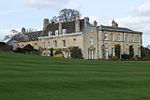Holywell, Lincolnshire

Holywell is a tiny settlement in the civil parish of Careby Aunby and Holywell, in the South Kesteven district of Lincolnshire, England. It lies 5.5 miles (9 km) north from Stamford and 6 miles (10 km) south-west from Bourne. It is a collection of houses around a country house and park. The park includes a small private church dedicated to St Wilfrid. Ornamental lakes have been restored over the last 20 years, and new gardens laid out. In 2009 the gardens were open to the public through the National Garden Scheme. Two venerated springs are reported in the village, Holy Well and St Winifred's. Only the location of the first is known. There are no other place names associated with venerated springs in Lincolnshire, although other Holy Wells exist such as those near the site of Sempringham Priory and nearby Ryhall.
Excerpt from the Wikipedia article Holywell, Lincolnshire (License: CC BY-SA 3.0, Authors, Images).Holywell, Lincolnshire
Castle Bytham Road, South Kesteven Careby Aunby and Holywell
Geographical coordinates (GPS) Address Nearby Places Show on map
Geographical coordinates (GPS)
| Latitude | Longitude |
|---|---|
| N 52.732285 ° | E -0.51531 ° |
Address
Home Farm House
Castle Bytham Road
PE9 4DT South Kesteven, Careby Aunby and Holywell
England, United Kingdom
Open on Google Maps










